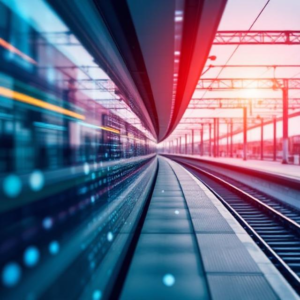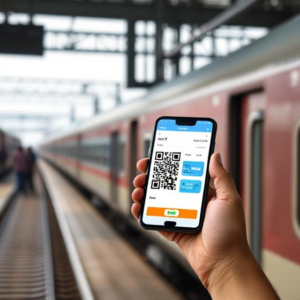Big Data in railway management refers to the use of large amounts of data (from sensors, passengers, trains, and more) to improve the overall functioning of the railways. It helps railways operate more efficiently, safely, and cost-effectively. Let’s break down how Big Data is used in simple terms:
1. What is Big Data?
- Big Data refers to the huge volume of data generated from various sources. This could be data about passengers, train schedules, weather conditions, ticket sales, train performance, and more.
- Think of it as massive amounts of information that are collected from sensors, GPS systems, mobile apps, and even social media. This data is then processed and analyzed to help make better decisions.

2. How Big Data is Used in Railway Management
a. Improving Train Schedules
- Railways use real-time data from sensors and GPS systems to track the location of trains. This helps to predict delays and adjust the schedule if needed. For example, if a train is running late due to weather or technical issues, the data can help inform passengers and reroute other trains to avoid delays.
- Big data also helps to optimize train timetables, ensuring that trains are running at the right times and efficiently connecting with other modes of transport, like buses.
b. Predictive Maintenance
- Trains and railway tracks are equipped with sensors that collect data about the train’s health and performance. This data is used to predict when parts might fail or need repairs before problems happen.
- For example, sensors can detect things like wear on the train’s brakes or engine performance issues. By analyzing this data, railways can schedule maintenance at the right time, reducing breakdowns and delays, and making the system safer for passengers.
c. Passenger Data for Better Services
- Big Data helps understand passenger patterns. Railways collect data on how many passengers travel at specific times, which stations are busiest, and which routes are most popular.
- Using this data, they can improve services by adding extra trains during busy times, improving the comfort at stations, or offering targeted promotions. For example, if data shows many passengers are traveling to a particular station, the railways can make that station more comfortable with more seating, better facilities, or faster services.
d. Optimizing Train Operations
- Big Data helps railways in managing train traffic on busy tracks. By analyzing traffic flow and historical data, railways can predict traffic congestion and adjust schedules or reroute trains to avoid delays.
- It also helps to optimize energy usage. For example, data can be used to find the most energy-efficient routes or the best speeds for trains, saving energy and reducing costs.
e. Safety and Security
- Big Data plays a key role in improving safety on trains. By analyzing patterns of accidents and incidents, railways can make changes to improve safety.
- It can also help monitor security systems at stations and on trains. For example, data from surveillance cameras, ticketing systems, and even social media can be used to spot potential security threats, allowing the railway authorities to take action quickly.
f. Ticketing and Revenue Management
- Big Data is used to track ticket sales and pricing trends. By analyzing when and where tickets are purchased, railways can adjust prices in real-time, offering discounts or increasing prices depending on demand. This is similar to how airline prices change.
- It also helps in demand forecasting. For example, if data shows there’s a higher demand for tickets in certain months, the railways can plan for more trains or increase services.
g. Improved Customer Experience
- Using customer data, railways can offer more personalized services. For example, apps and websites can recommend train routes or seat bookings based on past travel behavior.
- Big data also helps with real-time updates. Passengers can get live information about train arrival times, delays, and available seats, making their travel experience smoother.
h. Environmental Impact
- By analyzing data on fuel usage, energy consumption, and train operations, railways can adopt more sustainable practices. For example, they can use data to identify eco-friendly routes or reduce unnecessary train operations, lowering the environmental impact of railway systems.
3. Technologies Used to Manage Big Data in Railways
- Sensors: These collect data from trains, tracks, and stations, like temperature, speed, and condition of the trains.
- GPS Systems: These track the location of trains in real-time.
- Mobile Apps: Passenger apps collect data about user preferences, ticket bookings, and travel habits.
- Cloud Computing: This allows large amounts of data to be stored and processed efficiently, without requiring massive in-house infrastructure.
- Machine Learning and AI: These technologies analyze data patterns to predict outcomes (like potential failures or delays) and suggest improvements.
4. Benefits of Big Data in Railway Management
- Increased Efficiency: By analyzing data, railways can improve train schedules, reduce delays, and make better decisions.
- Cost Savings: Predictive maintenance and optimized operations can save money by preventing breakdowns and energy wastage.
- Improved Safety: Data helps track safety incidents and spot potential hazards before they become serious.
- Better Passenger Experience: Passengers get better services, such as real-time updates on train timings, and personalized recommendations.
- Environmental Benefits: Big Data helps in identifying ways to reduce energy consumption and carbon emissions.
Summary:
Big Data in railway management uses large amounts of data from sensors, GPS, and passenger interactions to make trains more efficient, safe, and comfortable. It helps in improving train schedules, predicting maintenance needs, offering personalized services to passengers, and making railways more eco-friendly. By analyzing data, Indian Railways can make smarter decisions that benefit both passengers and the environment, leading to a smoother, more reliable railway experience.
Keywords: Indian Railway, Railway










